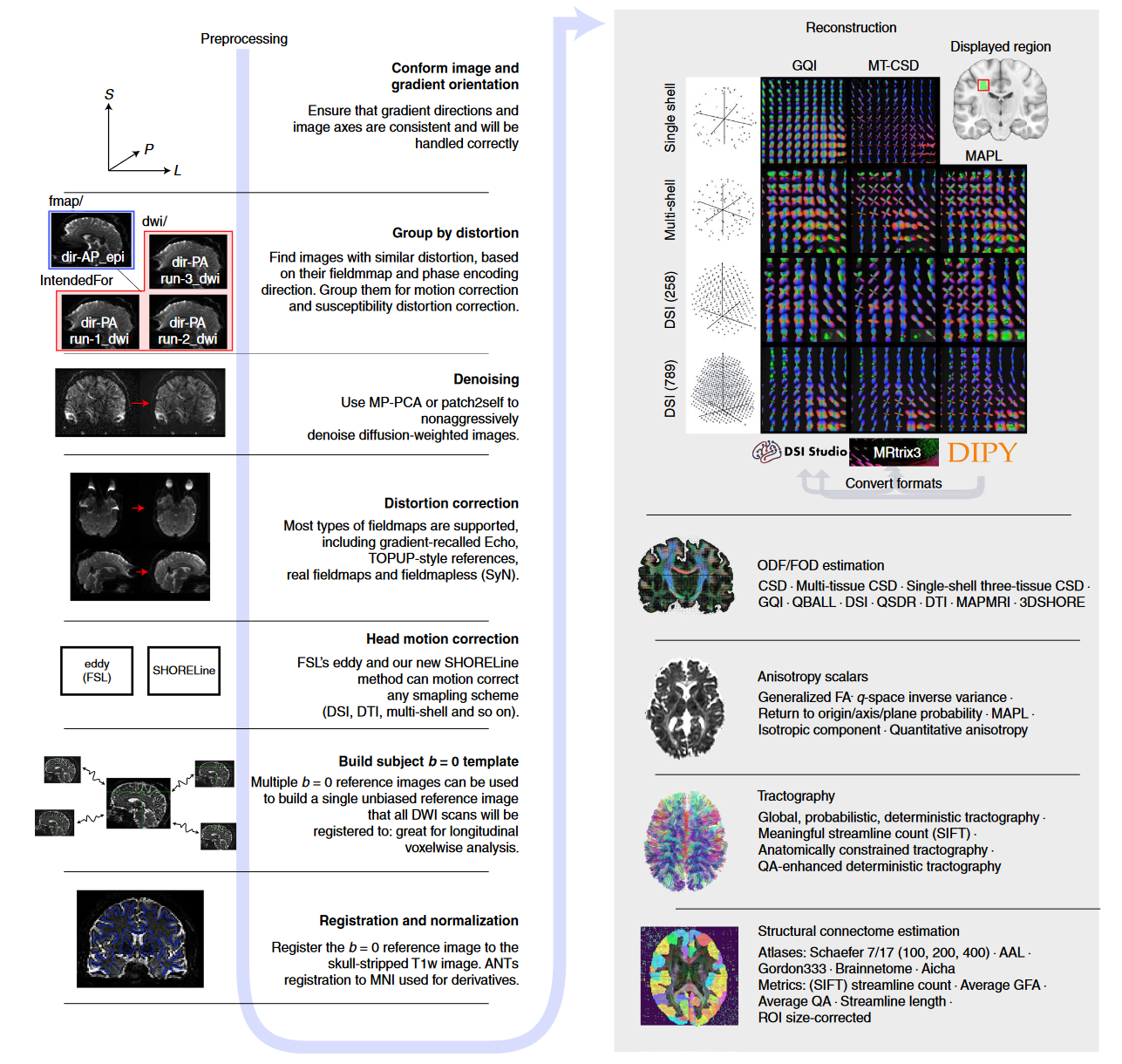
QSIprep的处理流程↑
根据QSIprep输出结果中的html所提到的方法如下,进行整理解释
Preprocessing was performed using QSIPrep 0.13.0, which is based on Nipype 1.6.0 (Gorgolewski et al. (2011); Gorgolewski et al. (2018); RRID:SCR_002502).
Anatomical data preprocessing
A total of 3 T1-weighted (T1w) images were found within the input BIDS dataset. All of them were corrected for intensity non-uniformity (INU) using
N4BiasFieldCorrection(Tustison et al. 2010, ANTs 2.3.1). A T1w-reference map was computed after registration of 3 T1w images (after INU-correction) usingmri_robust_template(FreeSurfer 6.0.1, Reuter, Rosas, and Fischl 2010). The T1w-reference was then skull-stripped usingantsBrainExtraction.sh(ANTs 2.3.1), using OASIS as target template. Spatial normalization to the ICBM 152 Nonlinear Asymmetrical template version 2009c (Fonov et al. 2009, RRID:SCR_008796) was performed through nonlinear registration withantsRegistration(ANTs 2.3.1, RRID:SCR_004757, Avants et al. 2008), using brain-extracted versions of both T1w volume and template. Brain tissue segmentation of cerebrospinal fluid (CSF), white-matter (WM) and gray-matter (GM) was performed on the brain-extracted T1w usingFAST(FSL 6.0.3:b862cdd5, RRID:SCR_002823, Zhang, Brady, and Smith 2001).Diffusion data preprocessing
Any images with a b-value less than 100 s/mm^2 were treated as a b=0 image. MP-PCA denoising as implemented in MRtrix3’s
dwidenoise(Veraart et al. 2016) was applied with a 5-voxel window. After MP-PCA, B1 field inhomogeneity was corrected usingdwibiascorrectfrom MRtrix3 with the N4 algorithm (Tustison et al. 2010). After B1 bias correction, the mean intensity of the DWI series was adjusted so all the mean intensity of the b=0 images matched across eachseparate DWI scanning sequence.FSL (version 6.0.3:b862cdd5)’s eddy was used for head motion correction and Eddy current correction (Andersson and Sotiropoulos 2016). Eddy was configured with a q-space smoothing factor of 10, a total of 5 iterations, and 1000 voxels used to estimate hyperparameters. A linear first level model and a linear second level model were used to characterize Eddy current-related spatial distortion. q-space coordinates were forcefully assigned to shells. Field offset was attempted to be separated from subject movement. Shells were aligned post-eddy. Eddy’s outlier replacement was run (Andersson et al. 2016). Data were grouped by slice, only including values from slices determined to contain at least 250 intracerebral voxels. Groups deviating by more than 4 standard deviations from the prediction had their data replaced with imputed values. Final interpolation was performed using the
jacmethod.A deformation field to correct for susceptibility distortions was estimated based on fmriprep’s fieldmap-less approach. The deformation field is that resulting from co-registering the b0 reference to the same-subject T1w-reference with its intensity inverted (Wang et al. 2017; Huntenburg 2014). Registration is performed with
antsRegistration(ANTs 2.3.1), and the process regularized by constraining deformation to be nonzero only along the phase-encoding direction, and modulated with an average fieldmap template (Treiber et al. 2016). Based on the estimated susceptibility distortion, an unwarped b=0 reference was calculated for a more accurate co-registration with the anatomical reference. Several confounding time-series were calculated based on the preprocessed DWI: framewise displacement (FD) using the implementation in Nipype (following the definitions by Power et al. 2014). The head-motion estimates calculated in the correction step were also placed within the corresponding confounds file. Slicewise cross correlation was also calculated. The DWI time-series were resampled to ACPC, generating a preprocessed DWI run in ACPC space with 2mm isotropic voxels.Many internal operations of QSIPrep use Nilearn 0.7.1 (Abraham et al. 2014, RRID:SCR_001362) and Dipy (Garyfallidis et al. 2014). For more details of the pipeline, see the section corresponding to workflows in QSIPrep’s documentation.
根据文章插图的描述,QSIprep的预处理为以下:
- 确认图像和梯度方向
- 根据失真度分组
- 降噪(MP-PCA or patch2self)
- 失真校正(distortion correction)
- 头动/eddy校正(head motion correction/Eddy current)
- 构建b0模板
- 注册和归一化
重建过程如下:
- MRtrix3, DSI Studio and DIPY
- ODF/FOD估计
- FA计算?
- 纤维追踪?
- 结构连接组学估计
根据html文件描述,首先是对解剖学数据的处理:
- ANTs的N4BiasFieldCorrection来进行强度不均匀性(intensity non-uniformity, INU)校正
- FreeSurfer使用mri_robust_template对T1w图像进行注册,得到T1w参考map
- ANTs的antsBrainExtraction.sh对T1w-reference进行颅骨剥离,以OASIS作为目标模板
- ANTs的antsRegistration通过使用step 3的T1w volume和template,对ICBM 152 Nonlinear Asymmetrical template 2009c进行非线性注册
- FSL的FAST对step 3进行脑组织分割,包括脑脊液(CSF)、白质(WM)和灰质(GM)
其次是对diffusion数据的处理:
- 任何b值小于100s/mm^2的图像都作为b=0的图像处理。
- 在MRtrix3的dwi denoise中实现的MP-PCA去噪,采用5体素窗口。
- 在MP-PCA之后,使用MRtrix3的dwibiascorrect和N4算法对B1场不均匀性进行校正。
- B1偏差校正后,调整DWI系列的平均强度,使所有b=0图像的平均强度在每个独立的DWI扫描序列中相匹配。
- FSL的EDD被用于头部运动校正和Eddy校正。
- 根据fmriprep的fieldmap-less(SDC)方法,校正易感性畸变的变形场。